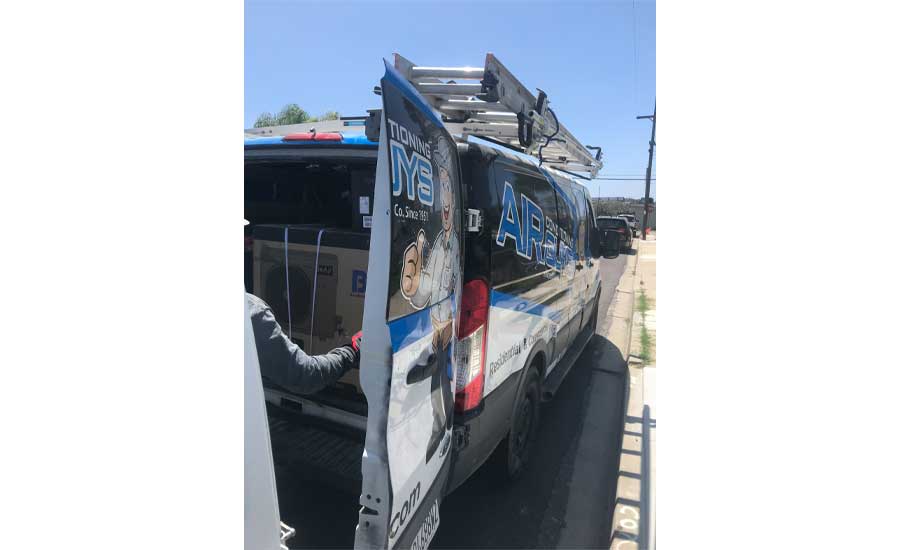“It’s becoming increasingly more difficult to obtain certain parts and equipment.”
The details vary depending on the contractor or distributor, but Jessica Hartley-Golino, operations manager for Isaac Heating & Air Conditioning in Rochester, New York, summed up the conventional perception as this pandemic year hits peak cooling season in the U.S.
Improvements Abroad, Tighter at Home
Availability in this country depends on conditions both here and in Mexico (among other nations). Guitze Messina, executive director of HARDI Mexico, reported that “the current trend in Mexico is positive” when it comes to availability. He noted a specific motor manufacturer had suffered from a government shutdown several weeks ago, but that “all other products are readily available.”
(As for demand, Messina said that demand in Mexico itself is 30 to 50 percent lower as a result of the year’s events.)

BRIGHTER HORIZON, BUT ...: HARDI's Tim Fisher sees improvements ahead for production capacity, based on recent progress in Mexico and China. However, he said, “For as long as there’s a need for social distancing, total output at manufacturing plants both domestically and around the world will remain below normal levels.”
Tim Fisher, market intelligence team leader for HARDI, agrees that “trends are generally positive, especially in comparison with the March/April figures.” He noted that “China and Mexico both still have moderate restrictions at land borders for ground transport” as of the first week of July, but he did not expect that to have a significant impact on supply.”
Fisher said that Chinese production has largely normalized following its February shutdown.
Manufacturer and distributor association representatives may agree that current overall conditions are improving globally, but Fisher also sees that the status quo on the ground varies in the U.S.
“HARDI distributor members have broadly indicated that they are either currently experiencing product shortages, or that they anticipate shortages in the near future,” he said, with 78 percent encountering trouble in a late June survey.
Move further along the chain to contractors, and assessments are more likely to reflect difficulty keeping up with demand.
For Hartley-Golino, temperatures running warmer than usual in the Northeast only aggravate any existing COVID-related demand challenges.
In the Midwest, owner Butch Welsch of Welsch Heating & Cooling in St. Louis also saw increased demand. He attributes much of that to the COVID-driven swell in the work-at-home population.
“If the two of you are not home all day, you don’t worry as much if the air conditioner is not operating at full capacity,” he said. More quality time with home systems has resulted in more attention where performance quality is lacking.

ADAPTATION: “I used lessons I learned from my father in the produce business to leverage our supply by reaching out to other brands and distributors in other states as well," said Louis Fuentes of Air Conditioning Guys in Chula Vista, California.
Moving further westward to California, Louis Fuentes is president of Air Conditioning Guys in Chula Vista.
“It seems that supply has increased slightly and in batches,” he said. “Trucks are delivering equipment to distributors, but a majority of the shipment already has ‘back ordered’ attached to them, so it makes a small dent as supply houses struggle to meet demand.”
Fuentes mentioned that the difficulty has run in both directions.
“Our sister company in Mexico experienced similar issues from U.S.-based manufacturers.”
Which Shortages Are the Shortest?
Regarding equipment types, HARDI’s Fisher said that his members overwhelmingly cited water heaters and finished air conditioning equipment as being the hardest to obtain.
“However, the availability of coils, motors, compressors, and IAQ is also limited,” he added.
At Isaac, Hartley-Golino has seen challenges with air purification product supply.
“Many of the materials used to produce the UV bulbs, for example, are outsourced and manufacturers are unable to obtain them,” she explained. Hartley-Golino said her office is commonly told that backorders in this category are at least twelve weeks out.
Things have gone more smoothly lately for Welsch. Manufacturing issues have only caused a hiccup there when a COVID case required a shutdown at his supplier for premade lightweight concrete pads. However, Welsch said the manufacturer gave his company a sufficient heads-up so that Welsch could stock up adequately.
That sits in contrast with the improvising that Fuentes had to do for a while at Air Conditioning Guys with regard to new systems.
“We had to adopt a strategy that we would not sell or promote a certain brand, but rather just go by capacity and pretty much whatever brand and efficiency we could find,” he said.
“Some customers would get brand X installed, and the next customer would get brand Z because equipment of the same brand was in short supply.”
Working With Distributors
Fuentes recalled that replacement and warranty parts then became the next problem.

SHIPPING SQUEEZE: Like many, Butch Welsch of St. Louis' Welsch Heating & Cooling experienced some shipment challenges. He has been told that the shortage-then-catch-up nature of so much product in general — beyond HVAC products — has strained the supply of drivers and trucks, which in turn has slowed down deliveries.
“A few smaller supply houses became the go-to place for parts and equipment,” he recalled, but eventually that ran its course, too, until manufacturers could begin to ramp up again.
These days, Hartley-Golino says that while distributors and manufacturers are making adjustments to try to keep up, the backlog is formidable. As a result, she said, “it’s hard to get confirmation on the equipment beyond a week or two.”
Shipping and warehousing is one area where Welsch has experienced more of an ongoing challenge. He has been told that the shortage-then-catch-up nature of so much consumer product in general has strained the supply of drivers and trucks, which in turn has slowed down HVAC deliveries.
“After much complaining on our part here,” Welsch said, “one of our distributors agreed to send their own truck to the factory a few times in order to get equipment we needed.”
That solution has worked pretty well, Welsch said, although that, in turn, reduced the distributor’s available fleet for its usual local routes. The distributor has tried to plug that gap with local carriers.
Welsch has also seen the smaller operating crews at parts suppliers result in greater lead times, although his company’s typical ordering lead times have provided some cushion.
The parts/equipment equation has trended the other way in Rochester.
“We’ve noticed more difficulty sourcing equipment than parts,” said Hartley-Golino, with the exception of the UV replacement bulbs.
Hartley-Golino’s team at Isaac is doing what it can to adapt.
“We have monitored and increased our inventory on certain items that we feel may be difficult to maintain.”
Fuentes has seen a different tactic evolve in his region.
“Some contractors have had a consignment program with their distributors for some time now,” he said, which enabled them to ride out the toughest times with a little less discomfort.
Fuentes said Air Conditioning Guys has adjusted by pre-ordering equipment from more than one place where they may have previously relied on a single source.
“I used lessons I learned from my father in the produce business to leverage our supply by reaching out to other brands and distributors in other states as well,” Fuentes explained.
He acknowledged distributors are in a tight spot, trying to get equipment to serve their existing local customers and minimize the impulse to shop elsewhere.
Behind and Ahead
The timing of stimulus checks contributed additional pressure to supply challenges, HARDI’s Fisher said.
“The federal stimulus checks that went out in mid-April drove household income up 13 percent, which then led to a surge in consumer spending in May and June,” he recounted. As Welsch mentioned, a newly attentive consumer base added to demand. Finally, Fisher said HVAC production did not rebound in May like industrials overall.
The result?
“Manufacturing levels remained at depressed levels just as the stimulus payments and stay-at-home orders were creating a perfect storm for residential demand.”
That phrase came up again in conservation with Welsch, although he cited additional pressures.
In Welsch’s evaluation, “The number of employees not working at many levels, from manufacturers to the freight lines to the local wholesalers, has had a greater impact than we might have originally been told.”
Add those who have not been willing to work and those with child care constraints, mix in the increased demand, “and you have a perfect storm situation,” he concluded.
The industry can remind itself that storms do pass.
“All in all, I think our industry has handled the pandemic, and the extremely unusual economic jolt it caused, probably better than might have been expected, considering it is not something that comes along very often,” said Francis Dietz, AHRI vice president of public affairs.
At HARDI, Fisher sees a silver lining for production capacity, based on recent progress in Mexico and China. He does warn, however, that because of safety measures currently in place, “’full capacity’ is not really full capacity.”
“For as long as there’s a need for social distancing,” Fisher said, “total output at manufacturing plants, both domestically and around the world, will remain below normal levels.”
Beyond personnel challenges in their own facilities, manufacturers may have damages to address elsewhere. Fuentes says he would not be surprised to see a significant number of contractors reevaluate their purchasing strategies based on how this year has gone.
“I can tell you my purchasing loyalty will be with those reps that reached out and did what they could to help get us equipment,” Fuentes said.
“Those that didn’t even reach out with a phone call will not get one from me during their forecasting/sales projection months.”








